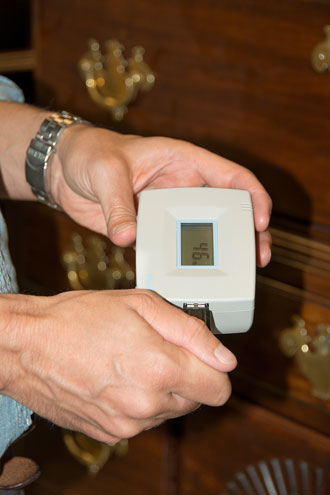The museum is taking a hard look at something that can be invisible to most of us – the environments where it stores and displays its artifacts. Historic Deerfield has recently test piloted a new way to track the environmental conditions of its more than 25,000 artifacts in its permanent collection. We purchased four PEM2, or Preservation Environmental Monitor, data loggers. These are electronic sensors that test the temperature and relative humidity (how much moisture is in the air) of an interior space. To begin, we sampled two storage and display areas on campus using the data loggers. The PEM2 devices, developed by the Image Permanence Institute (IPI®), are currently some of the best (and easiest to use) monitoring tools available to museums.
The advantage of this type of environmental monitoring system lies in part with its ease of use. Museum staff can download each device’s readings using a flash drive. Logging onto the IPI’s eclimate notebook website that data is then downloaded. The information is stored there, and can be read and shared with staff and outside conservators for maintenance and supervision of our interior environments. Having the software online allows for easier and user-friendly access, and also allows sharing of findings with other professionals.

Historic Deerfield staff can download PEM2 data onto a flash drive. By uploading the information onto a password protected website, they can track environmental conditions, and make changes when needed for the benefit of collection objects.
Historic Deerfield’s Curatorial Department Chair Amanda Lange and Collections Manager David Lazaro gained familiarity with the PEM2 devices recently during the General Conservation Survey funded by the Institute for Museum and Library Services (IMLS). Initial tests have proven successful, and we’ve applied for an National Endowment for the Humanities (NEH) Preservation and Access Grant to purchase fifteen more.
The additional monitoring equipment will allow the museum staff to gain a better understanding of these environments, analyze that data using state-of-the-art online programs, and then make changes for improvements. The grant also provides training with Conservator Mary Jo Davis on the use and placement of these monitoring devices as well as interpretation of this data by experienced professionals via password protected access. We will find out the results of the grant application in December – wish us luck!